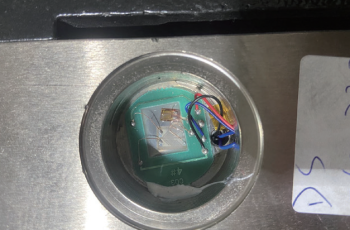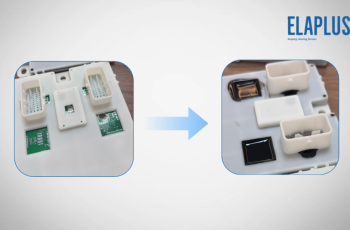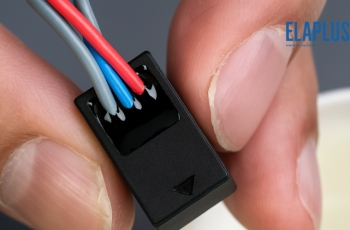Waterproof Adhesive Solution for Automotive Lights – SIPC 1859 Organic Silicon
In the automotive industry, waterproof bonding of car lights is an important part of ensuring long-term stability of lighting fixtures. Optical components such as headlights, taillights, and daytime running lights are prone to problems such as water leakage, delamination, or PC material aging in harsh environments such as high temperature, humidity, and ultraviolet radiation if they lack effective waterproof bonding protection. Elapluus car lamp waterproof bondingCore requirements for waterproof bonding of car lightsWhen carrying out waterproof bonding of car lights, the following key performance should be paid attention to:Efficient bonding of PC materials: Car lamp covers are mostly made of polycarbonate (PC) material, and the adhesive needs to ensure long-lasting and strong adhesion.Non flowing and de methanol: During the construction process, the colloid does not flow, and solidification does not release methanol, ensuring the safety of optical transparent parts and internal components.Aging resistance and corrosion resistance: Car lights must withstand environmental tests such as temperature differences, humidity, rain, and ultraviolet rays during long-term use. The adhesive should be anti-aging and not corrode the PC material.Recommended product: SIPC 1859 silicone adhesive sealantSIPC 1859 is a high-performance single component silicone adhesive sealant designed specifically for waterproof bonding of car lightsExcellent PC adhesion: Directly bond PC lampshades without the need for primer, ensuring long-lasting stability.Black, non flowing: easy to construct, neat and beautiful glue line.Methanol removal environmentally friendly formula: does not release methanol during the curing process, protecting optical components and internal circuits.Aging resistance and corrosion resistance: The adhesive strength is maintained during high temperature, humid heat, UV and other aging tests without damaging the PC substrate.Dual function of waterproof sealing: achieving dual protection of adhesion and waterproof sealing, effectively extending the service life of car lights.Application scenarios SIPC 1859 is widely used for waterproof bonding of various automotive lighting fixtures:Front headlight assembly:…
MoreSilicon gel for pressure sensor potting – high viscosity, high reliability and high protection
In the packaging protection of pressure sensors, the fluidity, viscosity, and stress release ability of the sealing adhesive often determine the long-term stability and reliability of the sensor. Especially in the face of complex environmental conditions (high humidity, high temperature, mechanical vibration), it is particularly important to select a suitable silicon gel. Today, we recommend a high-performance potting material SIGEL 1805 two-component addition molding silicon gel specially designed for pressure sensors, MEMS chips and precision circuit modules. Load cell gel encapsulation Load cell gel encapsulation1、 Product Features Highlights✅ Soft and elastic, excellent cushioningAfter curing, it forms a soft elastic body that can release mechanical stress under thermal cycling and vibration conditions, protecting the chip and leads from damage.✅ Excellent electrical insulation and protection performanceAfter curing, it has extremely low oil leakage and excellent dielectric properties, which can effectively isolate moisture and corrosive media, providing stable insulation protection for high-voltage circuits.✅ Outstanding aging resistance and weather resistanceLong term exposure to high temperature, high humidity, ozone, and ultraviolet environments results in stable performance, making it suitable for outdoor or automotive electronic sensor applications.✅ 1: 1-ratio additive curing systemEasy to mix, no by-products, low shrinkage rate, mild curing process, can be cured at room temperature or by heating, compatible with automatic glue filling production lines.2、 Typical application scenarios🔸 Pressure sensor encapsulation: used for overall protection of silicon-based chips and circuit board areas, preventing moisture intrusion and mechanical stress damage.🔸 Differential pressure/air pressure sensor packaging: Provides flexible buffering in the packaging cavity to ensure measurement sensitivity and long-term stability.🔸 MEMS、 Micro sensor module: provides stress relief and protective barriers for sensitive components.🔸 Automotive electronic module: suitable for high temperature and high humidity working conditions such as wheel speed sensors and intake pressure sensors. Application case of gel potting4、 Analysis of Technical AdvantagesLeak proof design:…
MorePressure sensor sealing solution | SIPC 2130 single component silicone adhesive sealant
In the fields of modern industry and automotive electronics, pressure sensors are widely used as key detection components in hydraulic, pneumatic, refrigeration, oil and gas transportation, automotive braking systems, and other scenarios. Its core function is to accurately perceive changes in external pressure and convert them into electrical signals.However, the sensor contains sensitive circuits and measurement cores inside, which can easily cause performance drift or even failure if exposed to moisture, dust, oil, and vibration for a long time.Therefore, sealing and sealing protection have become key links for the reliable operation of pressure sensors. Application Requirements AnalysisThe sealing material for pressure sensors needs to have the following performance characteristics simultaneously:one ️⃣ Waterproof and moisture-proof – prevent water vapor from entering and causing short circuits or signal drift;two ️⃣ Low hardness and excellent elasticity – balancing mechanical protection and stress buffering of internal components;three ️⃣ Excellent insulation performance – ensuring circuit safety and signal stability;four ️⃣ High and low temperature resistance and aging performance – suitable for complex working conditions from -40 ℃ to 250 ℃;five ️⃣ Single component system, easy to operate – convenient for production automation and batch process control.Recommended product by Yilian: SIPC 2130 silicone adhesive sealantSIPC 2130 is a neutral dealcoholized single component silicone sealant designed specifically for electronic devices and sensors.It performs well in waterproof sealing, dielectric insulation, high and low temperature resistance, chemical corrosion resistance, etc., and is suitable for bonding and potting protection of various substrates (such as metal, ceramic, plastic, PCB). Key Features Low viscosity and good flowability: suitable for comprehensive sealing of complex internal structures;Combining high mechanical strength and flexibility: balancing structural stability with cushioning and shock absorption;Excellent insulation performance: effectively preventing leakage and corona phenomena;Wide temperature range stability: temperature resistance range -60 ℃~220 ℃, suitable for alternating cold and hot environments;Resistant…
MoreSolution for copper plate sealing of dielectric switch: EP 1710 high thermal conductivity epoxy sealing adhesive
In power equipment and industrial electronic systems, the dielectric switch copper plate plays a dual role in current conduction and insulation protection. It must ensure reliable conductivity and operate stably for a long time in harsh environments such as high voltage, high temperature, and humidity.Therefore, the requirements for bronze medals and their packaging materials are extremely strict – thermal conductivity, moisture resistance, insulation, and crack resistance are all indispensable.And this is precisely the strength of Elaplus EP 1710 epoxy potting material. 1、 Product Introduction: EP 1710 Epoxy Sealing MaterialEP 1710A/B is a two-component solvent-free ambient temperature curing epoxy sealant developed specifically for applications requiring thermal protection such as motors, automotive electronics, power tools, reactors, and instruments. This product performs particularly well in the copper packaging application of dielectric switches, effectively isolating moisture and dust, and improving system stability and safety.2、 Core performance characteristics✅ Excellent adhesion and crack resistanceEP 1710 has a high-strength molecular network structure and can firmly bond with metal substrates such as copper, aluminum, and stainless steel. Its toughness design can effectively absorb thermal stress and prevent cracking and delamination caused by thermal cycling.✅ Low coefficient of linear expansion (CTE)Traditional epoxy sealant is prone to failure due to thermal expansion mismatch under alternating high and low temperatures. EP 1710 achieves low CTE characteristics and ensures structural dimensional stability by optimizing the formulation system.✅ High thermal conductivityIn response to the concentrated heating characteristics of dielectric bronze plates, EP 1710 adds high-efficiency thermal conductive fillers to achieve excellent thermal conductivity in the industry, which can quickly conduct internal heat and reduce hot spot temperature rise.✅ Excellent electrical insulation and long-term stabilityAfter curing, a dense three-dimensional cross-linked structure is formed, with high insulation resistance and excellent dielectric strength, ensuring no leakage risk between copper plates and maintaining stable electrical performance even…
MoreSolution for Sealing Motorcycle and Automotive Controllers – PUR 1680 Quick Curing Version
In today’s world where motorcycles and cars are increasingly digitized, controllers, as the core component of the “vehicle brain,” undertake key functions such as power management, drive control, and signal processing. The working environment is extremely harsh – external factors such as high temperature, humidity, oil pollution, vibration, electromagnetic interference, etc. can all cause electronic component failure. Therefore, selecting sealing materials with stable performance and high reliability is a key step in ensuring the long-term stable operation of the controller. 1、 The Importance of SealingElectronic controllers continuously generate heat during operation and are exposed to vibration and humid environments. Sealing materials not only provide insulation, waterproofing, moisture resistance, and shock protection, but also need to balance thermal conductivity and long-term reliability.For the fields of motorcycles and automobiles, a highly fluid, easily permeable, and stable curing sealant is an ideal choice to ensure the performance of controllers.2、 Glue requirementsIn the sealing process of motorcycle and automotive controllers, customers have raised the following requirements:one ️⃣ The operation time is about 1 hour, which is convenient for sealing, leveling, and defoaming;two ️⃣ Colloids need to have excellent fluidity and permeability, and be able to fully fill small gaps and complex structures;three ️⃣ After curing, it should maintain good flexibility and durability, be waterproof and moisture-proof for a long time, and ensure stable adhesion between the circuit board and the shell.3、 Recommended product: PUR 1680 Quick EditionPUR 1680 Quick Edition is a two-component solvent-free room temperature or heat cured polyurethane potting material designed specifically for electronic control modules, car control boxes, power modules, and other structural applications.Product FeaturesThe operable time is about 1 hour, meeting the medium speed production cycle;Low viscosity flow system, easily penetrates the gaps between windings, pins, and components;Excellent insulation and waterproof performance, effectively protecting circuit boards from moisture erosion;High flexibility…
MoreCase Study of Adhesive Used for Fixing Automotive Switch Wiring Harness | Fast curing, flexible and bending resistant, PVC sticks firmly and is not easy to crack!
In modern automobile manufacturing, the wiring harness system serves as a “neural network” for electrical signal transmission, responsible for connecting and controlling the electronic systems of the entire vehicle.In actual assembly, the fixing of switch wiring harnesses is particularly crucial – it is necessary to ensure firm adhesion while maintaining reliability under frequent bending or vibration conditions.Today, we will take you through a typical case to learn about a high-performance adhesive suitable for fixing automotive switch wiring harnesses – PUR 1601. Application scenariosIn the assembly process of automotive switch wiring harnesses, the wiring harness material is mostly PVC (polyvinyl chloride), which has a low surface energy. Traditional adhesives are prone to problems such as weak adhesion and cracking after bending.The customer’s requirements are as follows:one ️⃣ Can firmly adhere to PVC without detachmenttwo ️⃣ Bending 10 times without cracking, ensuring fatigue resistance performancethree ️⃣ Fast curing speed, suitable for automated dispensing production linesRecommended solution: PUR 1601 two-component fast curing polyurethane adhesivePUR 1601 A/B is a two-component solvent-free room temperature curing polyurethane adhesive designed specifically for the electronics and automotive assembly industries, with three core advantages: flexibility, strong adhesion, and fast curing.✅ Product Advantages Overview:Rapid curing: It can be cured and formed in a short time at room temperature, greatly improving production efficiency.Excellent PVC adhesion performance: can firmly bond with various substrates such as PVC, metal, rubber, etc.High flexibility and bending resistance: After curing, it can withstand multiple bending without cracking, suitable for dynamic parts.Excellent aging resistance and chemical properties: can resist oil stains, moisture, and thermal aging environments for a long time.Low VOC formula: compliant with ROHS/REACH environmental regulations, safe and odorless.Suitable for multiple processes: machine dispensing or manual mixing operation, strong compatibility.Application testing verificationIn the customer’s on-site test, after fixing the PVC wire harness with PUR 1601, the sample…
MoreApplication of motor magnetic ring bonding case: EP 2012 epoxy adhesive helps to combine high strength and high reliability
In modern motor manufacturing, the bonding process of magnetic rings (magnetic steel, magnetic tiles) directly affects the balance and long-term reliability of motor operation. With the development of motors towards high speed and high efficiency, traditional adhesives are prone to problems such as delamination and strength attenuation under high temperature and centrifugal force. How to achieve high-strength, temperature resistant, and stable magnetic ring bonding in a limited space has become a common technical challenge faced by manufacturing enterprises. Motor magnetic ring bonding 1、 Project BackgroundThe magnetic ring adhesive used by the customer in the production process has a slow curing speed and insufficient bonding strength, resulting in loose magnetic rings and significant thrust fluctuations during high temperature and vibration testing. The main issues include:Adhesive strength does not meet the standard: there is a risk of slip in the magnetic ring under centrifugal load;Poor thermal stability: After 80 ° C thermal cycling, the thrust value fluctuates by more than 10%;Long curing time: limited production pace, difficult to meet the requirements of rapid assembly;Complex surface treatment: high cleaning requirements for adhesive substrates, which can easily affect consistency.In response to the above issues, ELAPLUS recommends customers to use EP 2012 epoxy adhesive and achieve a dual improvement in magnetic ring bonding strength and batch production efficiency through process optimization. 2、 Adhesive requirements and process parametersGlue requirements:Colloidal color: black;Curing conditions: 80 ° C for 1 hour;Thrust requirement: Stable at around 800 N;Adhesive materials: iron core metal and magnetic ceramic.Process suggestion:A. Mix component B evenly in a weight ratio of 100:45;Apply evenly to the clean and dry adhesive surface;After settling and draining the bubbles, proceed with assembly and positioning;Curing at 80 ° C for 1 hour, or curing at room temperature for 24 hours.After verification, this process balances production efficiency and adhesive strength, and significantly…
MoreSolution for LED hard light strip sealing: EP 1708 (7 #) High strength protection of transparent epoxy sealing adhesive
With the rapid development of LED lighting technology, LED rigid strips have been widely used in commercial lighting, display light boxes, outdoor advertising, car light modules, and other fields. It has the advantages of high brightness, long lifespan, and energy-saving stability. However, in long-term use, the moisture, dust, corrosion, and mechanical impact protection of LED hard light strips become key challenges.In this application context, choosing a suitable LED hard light strip sealing adhesive can not only effectively improve product protection performance, but also extend service life, improve light quality and overall reliability. This article will introduce the typical application and performance advantages of Elaplus EP 1708 (7 #) transparent epoxy sealant in LED hard light strips.1、 The necessity of LED hard light strip encapsulationLED hard light strips are usually composed of aluminum substrates, LED beads, resistors, capacitors, and other components, which are highly susceptible to external environmental influences when exposed to air.The main reasons for its failure include:Moisture infiltration leads to short circuit or blackening of the circuit;Dust and oil pollution adhesion affect heat dissipation and light efficiency;Long term illumination leads to thermal stress cracking;Solvent and chemical erosion of component solder joints.Therefore, using transparent epoxy sealant for overall sealing and encapsulation can not only effectively isolate moisture and pollutants, but also provide structural support and electrical insulation protection for the light strip.2、 Glue requirementsThe LED hard light strip sealant needs to meet the following performance requirements simultaneously:High transparency: ensuring that light efficiency is not affected;Strong yellowing resistance: no yellowing or turbidity after prolonged illumination;Good electrical insulation: prevents short circuit or arc breakdown;High and low temperature resistance: stable in environments ranging from -40 ° C to 100 ° C;Strong adhesion and no cracking: Good adhesion to aluminum substrates, plastic lampshades, and PCBs;Easy to construct, high curing efficiency: suitable for automated production…
More








